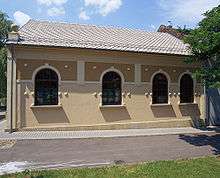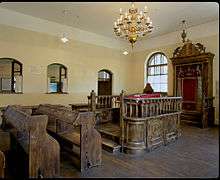Oświęcim Synagogue
The Oświęcim Synagogue, also called the Auschwitz Synagogue, is the only active synagogue in the town of Oświęcim, Poland. The formal, as well as pre-war, name of the synagogue is Khevre Loymdei Mishnayos (English translation: Association of Those Who Study Mishna). It is now part of the Auschwitz Jewish Center, which includes a Jewish Museum, a cafe in the house of Syzmon Kleuger and an education center.
| Chevra Lomdei Mishnayot Synagogue | |
|---|---|
 | |
| Religion | |
| Affiliation | Orthodox Judaism |
| Rite | Ashkenaz |
| Status | Active synagogue |
| Location | |
| Location | Jan Skarbek square, Oświęcim, Poland |
| Architecture | |
| Completed | 1918 |
Background
The Oświęcim synagogue was the first building restored to the Jewish community under the Polish government’s post-Communism law governing the restitution of Jewish communal property seized by German occupiers during World War II, and retained by the post-war Communist government.[1] The building was claimed by, and is now owned by, the Jewish community of nearby Bielsko-Biala.
History

The synagogue was built circa 1913. During World War II, the Nazis demolished its interior and used the building as a munitions depot. After the end of war, a small group of Jewish survivors restored the synagogue to its proper function. However, the custodians soon left Poland and the synagogue ceased to operate.[2]
In the 1970s, under communist Poland, the empty building was used as a carpet warehouse. The synagogue reopened on September 11, 2000, completely restored to its pre-war condition by the Auschwitz Jewish Center Foundation of New York, at the cost of one million dollars. It is an active synagogue used for prayers by groups and individuals visiting Auschwitz. The adjoining house was purchased by the foundation and turned into a contemporary museum called the Auschwitz Jewish Center (Żydowskie Centrum Edukacyjne). It depicts the life of Jews in pre-war Oświęcim.[3] Both the synagogue and the Jewish center are affiliated with the Museum of Jewish Heritage in New York.[4] Presently at the Synagogue, there is an Auschwitz Jewish Center, a museum and a cultural center, focused on Jewish heritage, reconciliation through art and intercultural dialogue.
Szymon Kluger's house
The house of Szymon Kluger forms part of the complex that includes the synagogue. It now houses a cafe.[5] The last native Jew of Oświęcim died in 2000. His death in 2000 brought to an end the old Jewish community of Oświęcim.[6]
The great synagogue
At the time of the Nazi invasion, more than half the population of Oświęcim was Jewish. The community was over 400 years old and there were then more than 20 synagogues in the city. [7] The Auschwitz synagogue was not the most important synagogue in Oświęcim. The better known and bigger Great Synagogue of Oświęcim was destroyed by the Nazis on November 29, 1939,[8] and its remains were demolished.
Notes
- "Synagogue Near Auschwitz Restored to Jews". The New York Times. March 12, 1998.
- The Chevra Lomdei Mishnayot Synagogue history; at ajcf.org
- "Synagogue Reopens Near Auschwitz After 60 Years". New York Times News Service. 18 February 2001.
- Museum of Jewish Heritage Archived 2008-07-03 at the Wayback Machine; at www.mjhnyc.org
- "Café Oshpitzin Community Recognition". Auschwitz Jewish Center. August 19, 2013.
- Mandell, Hinda (August 19, 2009). "Bargain Shopping in the Shadow of Auschwitz: Letter from Oswiecim". Jewish Daily Forward. Retrieved 11 February 2013.
- Video presentation; at ajcf.org
- Lebovic, Matt (4 July 2019). "Memorial for 400-year-old Jewish community to be built in town next to Auschwitz". The Times of Israel. Retrieved 19 February 2020.
References
- Lucyna Filip; Jews in Oswiecim 1918–1941; Oswiecim; 2005.